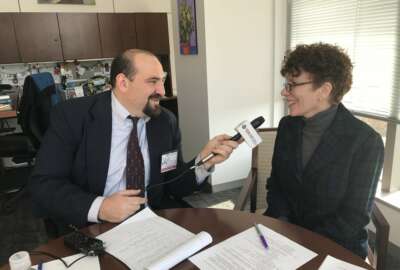
Interior, NSF join the bots bandwagon to stop doing ‘low-value’ work
NSF will use robotics process automation to improve its intergovernmental transactions, while Interior will apply bots to improve its electronic invoice processing.
The Treasury Department’s Bureau of Fiscal Service is bringing robots to two other agencies after a successful pilot of its own.
The Office of Financial Innovation and Transformation (OFIT) announced today it will work with the Interior Department and the National Science Foundation to bring robotics process automation (RPA) to their financial systems.
“They are drilling down into some of the problem areas that their organizations have,” said Adam Goldberg, executive architect for OFIT in an exclusive interview with Federal News Radio. “At the NSF, it’s going to be with their intergovernmental transactions, whereas at the Interior Department, they will be looking at their electronic invoicing processes. Both of these areas are of interest to them, but also are very important to a lot of the policies and efforts that are happening in the government today.”
RPA is software that takes over manual and redundant processes, similar to a macro in Excel, to relieve employees of “low value” work.
Goldberg said the RPA can take the data from one application and more easily combine it with data from other sources to complete a task.
The Fiscal Service tested out RPA as well as blockchain technology over the past year. The blockchain pilot focused on physical asset inventory control with cell phones.
The RPA pilot looked at streamlining common financial management processes performed at agencies.
After seeing the potential in these technologies, OFIT put out a call for ideas from agencies. Marshall Henry, a OFIT program manager, said the goal was to promote innovation in financial management.
“We thought it would be a great idea to partner with other agencies rather than just funding pilots or proofs of concepts ourselves,” he said. “We looked at those ideas and tried to find ideas that would have broad impact across the government, and that we could really get some good lessons learned to share across the government. The two that we are working with were the two ideas that we felt represented the most common benefit across the government.”
OFIT received 10 ideas from six agencies addressing everything from pilot ideas to suggestions for how to streamline financial reporting.
The projects needed to be ready to return benefits in six-to-eight months and meet four criteria:
- Increase financial management productivity.
- Reduce waste by reducing low value financial management activities.
- Improve program effectiveness.
- Achieve economies of scale with common approaches.
“We are using the contributions from the agencies as part of our role as the managing partner of the financial management line of business that would allow them to have a great participation in how those funds are being used to improve financial management,” said Goldberg.
He added he couldn’t say how much these pilots were costing because Interior and NSF are running acquisitions to bring in vendors to provide these RPA services.
“The projects will mirror some of the projects we’ve already done with RPA or digital ledger technology where the projects last approximately six-to-eight months. It’s a fairly small scope where we get discrete results at the end of that period of time,” Goldberg said. “They are similar in the fact they all have to come out with the results presented in a similar way. For example, how much were you spending on this before? How many FTEs or how much resources were being expended before? How much is being expended afterwards? We also are giving latitude on what business processes they want to focus on. It was something that within our own pilot, we gave the Fiscal Service that choice as well.”
He said some of the other ideas that didn’t make the initial cut remain viable options and OFIT is working with those agencies to further develop those concepts.
Several agencies also have had success with RPA. NASA is using four bots to improve grants management. The General Services Administration tested RPA to improve the time and accuracy of procurement actions.
At OFIT, Henry said the longer term goal is take the lessons learned from Interior and NSF and share them governmentwide.
“We are picking the pilots based on the fact the automation they are doing is for some financial management processes that will actually involve common systems across the government,” he said. “We will have a forum to help share that across the government, and it helps promote better financial management.”
Henry added the pilots align with Treasury’s 10-year vision to improve the efficiency and effectiveness of agency financial management.
Goldberg said another longer term goal with the RPA is whether the bot could be “lifted and shifted” to another agency.
“Often times there are slight differences in what one agency does to another and it may not be possible, and these pilots will help us further explore that,” he said. “We are looking at other things like policies or internal controls that agencies may need to consider when working with a robot that may or may not be different when you are working with a human performing the same actions.”
Goldberg said industry also has a role in the expansion of these emerging technologies. He said OFIT is working with industry associations such as ACT-IAC and the Association of Government Accountants to reach other contractors providing these types of technologies.
Copyright © 2025 Federal News Network. All rights reserved. This website is not intended for users located within the European Economic Area.
Jason Miller is executive editor of Federal News Network and directs news coverage on the people, policy and programs of the federal government.
Follow @jmillerWFED






